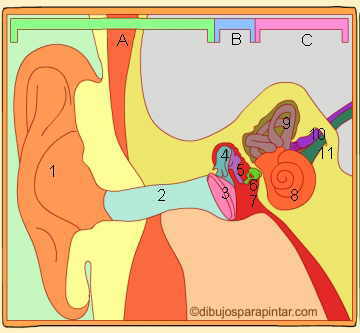Contents
Function of the sense of hearing
What is the ear?
The ear is the organ responsible for hearing and balance . The visible part is the ears or ears, which are only the external part of the hearing system and are only responsible for capturing sound waves. Inside the ear are other complementary systems that allow sound waves to be transmitted to the brain.
See the great importance of the auditory system for health and how it works in depth.
Ear functions and importance of hearing
The primitives needed to hear well for their survival , since the ear allowed them to capture the sounds of animals that could devour them. Although today there are virtually no danger of this type for Man, good hearing also is necessary to avoid many accidents, especially in today ‘s world, where more and more distractions and more cars than we can run if we are not well there attentive to our senses.
Good hearing is also necessary in order to communicate with others . To talk to other people, we need to hear what they are saying. The person with deafness has communication problems, not understanding well what other people tell him. Communication is so important that hearingless people develop super complex sign language to compensate for hearing loss!
In the semicircular canals of the inner ear is the sense of balance , which is the ability to spatially orient the organism. People who have ear problems may also have impaired sense of balance and suffer from vertigo or dizziness.
How does the ear work?
The ear is an organ in charge of collecting sound waves from the outside and transforming them into nerve impulses that are conducted to the brain.
The functioning of the ear organ is as follows:

The sound waves are collected by the auricles (ears) that have the shape of a fan to perform this function properly.
The sound waves, collected by the pinna, penetrate through the ear canal until reaching the eardrum .
After crossing the ear canal, sound waves strike the tympanic membrane .
As it strikes the eardrum, it begins to vibrate .
The vibration of the eardrum is picked up by the hammer, anvil and stirrup bones , which amplify the vibration .
The vibratory impulses pass to the inner ear through the oval window , where they are picked up by the cochlea and are transformed into electrical impulses by the hair cells that line the inside of the cochlea or snail.
Through the auditory nerve , electrical impulses are carried to the brain, which interprets them as sounds.
Parts of the ear

Illustrative drawing of the parts of the human ear inside.
A – External ear
1. Auricle, auricle or ear
2. Ear canal: in humans it measures about 2.5 cm and is covered with villi of the tragus and glands that secrete cerumen or ceruminous glands. The villi and earwax manage to trap dust and other particles that can penetrate the ear.
B – Middle ear
3. Eardrum
4. Hammer
5. Anvil
6. stirrup
7. Pharyngeal tuba (Eustachian tube)
C – Inner ear
8. Cochlea or snail
9. Semicircular canals
10. Vestibular nerve
11. auditory nerve
Are the ears connected to the nose or throat?
Yes. The middle ear communicates with the throat and nose through the Eustachian tube. This communication has the function of allowing the entry and exit of air that fills the cavity of the middle ear (tympanic cavity). In this way, the pressure on both sides of the eardrum is balanced.








